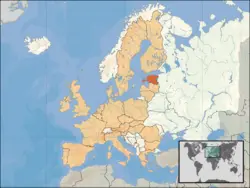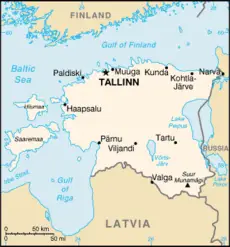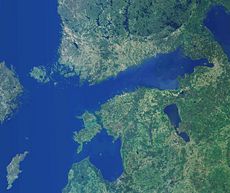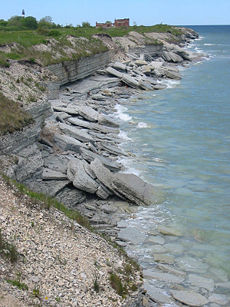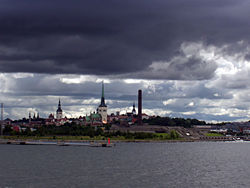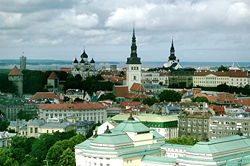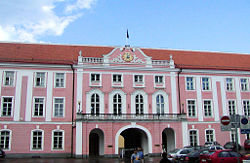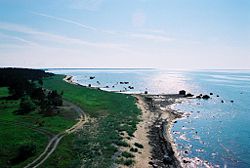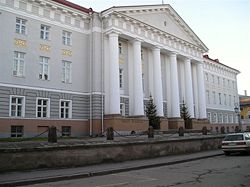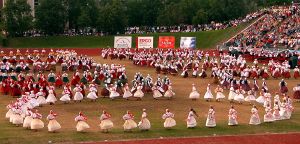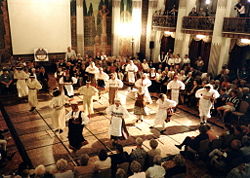Estonia
| Eesti Vabariik Republic of Estonia |
||||||
|---|---|---|---|---|---|---|
|
||||||
| Anthem: Mu isamaa, mu õnn ja rõõm (English: "My Fatherland, My Happiness and Joy") |
||||||
| Location of Estonia (orange) – on the European continent (camel white) – in the European Union (camel) [Legend] |
||||||
| Capital | Tallinn1 | |||||
| Largest city | Tallinn | |||||
| Official languages | Estonian2 | |||||
| Recognized regional languages | Võro, Setu | |||||
| Ethnic groups (2020) | 68.4% Estonians, 24.7% Russians, 1.9% Ukrainians, 0.8% Belarusians, 0.6% Finns 3.4% others[1] |
|||||
| Demonym | Estonian | |||||
| Government | Parliamentary republic | |||||
| - | President | Kersti Kaljulaid | ||||
| - | Prime Minister | Kaja Kallas | ||||
| Independence from | Russia | |||||
| - | Autonomy declared | 12 April 1917 | ||||
| - | Independence declared Officially recognised |
24 February 1918 2 February 1920 |
||||
| - | 1st Soviet occupation | 1940–1941 | ||||
| - | German occupation | 1941–1944 | ||||
| - | 2nd Soviet occupation | 1944–1991 | ||||
| - | Independence restored | 20 August 1991 | ||||
| EU accession | 1 May 2004 | |||||
| Area | ||||||
| - | Total | 45,227 km² (132nd4) 17,413 sq mi |
||||
| - | Water (%) | 4.45% | ||||
| Population | ||||||
| - | 2019 estimate | |||||
| - | census | 1,294,455[3] | ||||
| - | Density | 29.22/km² (148th) 75/sq mi |
||||
| GDP (PPP) | 2020 estimate | |||||
| - | Total | $49.644 billion[4] | ||||
| - | Per capita | $37,033[4] (37th) | ||||
| GDP (nominal) | 2020 estimate | |||||
| - | Total | $30 billion[4] (97th) | ||||
| - | Per capita | $22,986[4] (35th) | ||||
| Gini (2017) | 30.4[5] | |||||
| Currency | Euro4 (EUR) |
|||||
| Time zone | EET (UTC+2) | |||||
| - | Summer (DST) | EEST (UTC+3) | ||||
| Internet TLD | .ee5 | |||||
| Calling code | [[+372]] | |||||
| 1 | The Supreme Court and one ministry are based in Tartu. | |||||
| 2 | According to the Constitution, Estonian is the sole official language.[6] In southern counties, Võro and Seto are spoken along with it. Russian is spoken in parts of Ida-Virumaa and Tallinn. | |||||
| 3 | Including 5.4% Võros and 0.93% Setos.[7] | |||||
| 4 | 47,549 km² (18,359 sq mi) were defined according to the Treaty of Tartu in 1920 between Estonia and Russia. Today, the remaining 2,323 km² (897 sq mi) are part of Russia. The ceded areas include most of the former Petseri County and areas behind the Narva river including Ivangorod (Jaanilinn). Pechory remains under Russian administration. | |||||
| 5 | Also .eu, shared with other member states of the European Union. | |||||
Estonia (older English spelling Esthonia), officially the Republic of Estonia (Estonian: Eesti or Eesti Vabariik), is a country in Northern Europe. Estonia has land borders with Latvia to the south and Russia to the east. It is separated from Finland in the north by the Gulf of Finland and from Sweden in the west by the Baltic Sea.
Due to its strategic location, Estonia was dominated by foreign powers through much of its history. The past eight centuries have seen the domination variously of Denmark, Poland, Sweden, Germany and Russia. Nevertheless, Estonians have maintained their unique cultural identity. Forcibly incorporated into the Soviet Union in 1940 through a secret amendment to the August 1939 Molotov-Ribbentrop Pact between the Soviet Union and National Socialist Germany, it remained until the USSR's collapse 51 years later.
Estonia has been struggling to recreate itself since the 1991 collapse of the Soviet Union and the last Russian troops left in 1994. Despite allegations of corruption by some within the top levels of government, it has nonetheless developed a stable democracy. One of the more prosperous former Communist states, it enjoys a high degree of technological advancement. The government attempts to be open and transparent and has focused on strengthening its ties to the West. In 2004 it became a full member of both the European Union and the North Atlantic Treaty Organization (NATO).
In 1944 under Soviet occupation, the Jaanilinn (Ivangorod) and Petseri (Pechory) regions were annexed to the Russian SFSR. The legal status of these territories, the border question, remains unsettled between Republic of Estonia and the Russian Federation, successor of Soviet Union.
One of the most burdensome legacies of the Soviet era is widespread environmental pollution. The nation has suffered extensive contamination of its topsoil and underground water supply by the systematic dumping of jet fuel at six Soviet army air bases. Near the site of a former uranium enrichment plant, about 1,200 tons of uranium and about 750 tons of thorium had been dumped into the Gulf of Finland. Area residents have suffered severe health problems attributed to this pollution.
The Estonian language, along with closely related Finnish and Hungarian, is one of the few official languages of the European Union that is not of Indo-European origin.
Geography
Estonia is a low, flat country covering 17,462 square miles (45,226 square kilometers). It is about the size of the US states of Vermont and New Hampshire combined. Estonia has a long, shallow coastline (1,393 kilometers) along the Baltic Sea marked by numerous bays, straits, and inlets, with 1,520 islands dotting the shore. The two largest islands are Saaremaa (literally, island land), at 1,032 square miles (2,673 square kilometers), and Hiiumaa, at 382 mi² (989 km²). The two islands are favorite Estonian vacation spots and are large enough to constitute their own counties.
The country's highest point, Suur Munamägi (Egg Mountain), is in the hilly southeast and reaches 1,043 feet (318 meters) above sea level. Estonia is covered by about 700 mi² (18000 km²) of forest. Arable land amounts to about 3,575 mi² (9260 km²). Meadows cover about 970 mi² (2520 km²), and pastureland covers about 700 mi² (1810 km²). There are more than 1,400 natural and artificial lakes in Estonia. The largest of them, Lake Peipsi (1,372 mi² or 3,555 km²), forms much of the border between Estonia and Russia. Located in central Estonia, Võrtsjärv is the second-largest lake (104 mi² (270 km²). The Narva and Emajõgi are among the most important of the country's many rivers. The longest are the Võhandu (100 mi or 162 km), the Pärnu (90 mi or 144 km), and the Põltsamaa (about 84 mi or 135 km).[8]
Oil shale (or kukersite) and limestone deposits, along with forests which cover 47 percent of the land, play key economic roles in this generally resource-poor country. There are many rivers in the country. Estonia also boasts numerous bogs, and 2,357 miles (3794 km) of coastline. [9].
Climate
Estonia lies in the northern part of the temperate climate zone and in a transition zone between maritime and continental climate. Because Estonia (and all of Northern Europe) is continuously warmed by the Gulf Stream, it has a mild climate despite its northern latitude. The Baltic Sea causes differences between the climate of coastal and inland areas.
The average annual temperature in Estonia is 40° Fahrenheit (4.5 ° Celsius). The average temperature in February, the coldest month of the year, is 22°F (-5.2° C). The average temperature in July, which is considered the warmest month of the year, is 62.6° F (17° C).[8]
Estonia is in a humid zone in that the total amount of precipitation is greater than total evaporation. There are about 160 to 180 rainy days a year, and average precipitation is greatest on the western slopes of the Sakala and Haanja Uplands. Snow cover, which is deepest in the south-eastern part of Estonia, usually lasts from mid-December to late March.
Environmental issues
One of the most burdensome legacies of the Soviet era is widespread environmental pollution. The worst offender was the Soviet military. On military installations covering more than 300 mi² (800 km²) of Estonian territory, the army dumped hundreds of thousands of tons of jet fuel, improperly disposed of toxic chemicals, and discarded outdated explosives and weapons in coastal and inland waters. In the 1990s, during the army's withdrawal from Estonia, extensive damage was done to discarded buildings and equipment. In October 1993, the Estonian Ministry of Environment issued a preliminary report summing up the degradation it had surveyed. The report described extensive contamination of Estonia's topsoil and underground water supply by the systematic dumping of jet fuel at six Soviet army air bases. At the air base near Tapa, site of the worst damage, officials estimated that over two square miles (six square kilometers) of land were covered by a layer of fuel; more than four square miles (11 km²) of underground water were said to be contaminated. The water in the surrounding area was undrinkable. With Danish help, Estonian crews began cleaning up the site, at an estimated cost of EEK4 million. The Ministry of Environment assessed the damage to the country's topsoil and water supply at more than EEK10 billion. However, the ministry was able to allot only EEK5 million in 1993 for cleanup operations.
In a 1992 government report to the United Nations Conference on the Environment and Development, Estonia detailed other major environmental concerns. For instance, for several consecutive years Estonia had led the world in the production of sulfur dioxide per capita. Nearly 75 percent of Estonia's air pollution was reported to come from two oil shale-based thermal power stations operating near Narva. The mining of oil shale in northeastern Estonia also left gigantic mounds of limestone dotting the region. Near the town of Sillamäe, site of a former uranium enrichment plant, about 1,200 tons of uranium and about 750 tons of thorium had been dumped into the Gulf of Finland. This was said to have caused severe health problems among area residents. In the coastal town of Paldiski, the removal of waste left by Soviet army nuclear reactors was also a major concern. The combined cost of environmental cleanup at both towns was put at more than EEK3.5 billion.
Resources and land use
Estonia has few natural resources that include shale oil (kukersite), peat, phosphorite, amber, cambrian blue clay, limestone, and dolomite. Much of Estonia's surface and groundwater has been contaminated. Forests and woodlands cover nearly half of the country; arable land, pastures, and other uses make up the remainder of land uses.
History
Ancient history
Human settlement in Estonia became possible 11,000 to 13,000 years ago, when the last glaciation receded. The oldest known settlement in Estonia is the Pulli settlement, which was located on the banks of the river Pärnu, near the town of Sindi, in southern Estonia. According to radiocarbon dating, it was settled around 11,000 years ago, at the beginning of the ninth millennium B.C.E.
Evidence of hunting and fishing communities existing around 6500 B.C.E. has been found near the town of Kunda in northern Estonia. Bone and stone artifacts similar to those found at Kunda have been discovered elsewhere in Estonia, as well as in Latvia, northern Lithuania, and southern Finland. The Kunda culture belongs to the middle stone age, or Mesolithic period.
The end of the Bronze Age and the early Iron Age were marked by great cultural change. The transition to farming, still the core of Estonian economy and culture, was the most significant. From approximately the first to fifth centuries C.E., farming became widely established, the population grew, and settlement expanded. Cultural influences from the Roman Empire reached Estonia, and this era is therefore also known as the Roman Iron Age.
A more troubled and war-ridden middle Iron Age followed with external dangers coming both from the Baltic tribes, who attacked across the southern land border, and from overseas. Several Scandinavian sagas refer to campaigns against Estonia. During the Viking era, Estonian pirates conducted similar raids, sacking and burning the Swedish town of Sigtuna in 1187. [10]
Christianity
By the early thirteenth century, Estonia was divided into eight large counties—Saaremaa, Läänemaa, Rävala, Harju, Viru, Järva, Sakala, Ugandi, and many smaller ones. Annual consultations were held by representatives and constituents of several counties and developments took the direction of establishing a state. Estonia until this time retained a pagan religion centered around a deity called Tharapita.
Estonia was Christianized when the German "Livonian Brothers of the Sword" conquered southern Estonia (German: Livland) as part of the Northern Crusades in the early thirteenth century. At the same time, Denmark attempted to take possession of northern Estonia. Estonia was consolidated under the two forces by 1227. Northern Estonia remained a possession of Denmark until 1346. Reval (known as Tallinn since 1918) was given its Lübeck Rights in 1248 and joined the Hanseatic League at the end of the thirteenth century. In 1343, the people of northern Estonia and Saaremaa rebelled against German rule in the St. George's Night Uprising, which was put down by 1344. There were unsuccessful Russian invasions in 1481 and 1558. After 1524, during the Protestant Reformation, Estonia converted to Lutheranism.
Sweden and Russia
During the Livonian War in 1561, northern Estonia submitted to Swedish control, while southern Estonia briefly came under the control of Poland in the 1580s. In 1625, mainland Estonia came entirely under Swedish rule. Estonia was administratively divided between the provinces of Estonia in the north and Livonia in southern Estonia and northern Latvia, a division that persisted until the early twentieth century.
In 1631, the Swedish king Gustavus Adolphus forced the nobility to grant the peasantry greater rights, although serfdom was retained. In 1632, a printing press and Tartu University were established in the city of Dorpat (known as Tartu since 1918). This period is known in Estonian history as "the Good Old Swedish Time."
Following the Great Northern War, the Swedish Empire lost Estonia to Russia (1710 de facto, and 1721 de jure, by the Treaty of Nystad). However, the upper classes remained primarily Baltic Germans. The war devastated the population of Estonia, which recovered quickly. Although the rights of peasants were initially weakened, serfdom was abolished in 1816 in the province of Estonia and in 1818 in Livonia.
Gaining independence
As a result of the abolition of serfdom and the availability of education to the native Estonian-speaking population, an active Estonian nationalist movement began in the nineteenth century. It began on a cultural level, resulting in the establishment of Estonian language literature, theater and professional music and the formation of an Estonian national identity. Among the leaders of the movement were Johann Voldemar Jannsen, Jakob Hurt and Carl Robert Jakobson. Significant accomplishments were the publication of the national epic, Kalevipoeg, in 1862, and the organization of the first national song festival in 1869.
In response to a period of Russification initiated by the Russian Empire in the 1890s, Estonian nationalism took on more political tones, with intellectuals first calling for greater autonomy, and later, complete independence, from the Russian empire. Following the German victories against the ((Russian Army of 1917 and the Russian October Revolution, Estonia declared itself an independent republic on February 24, 1918. After winning the Estonian Liberation War against Soviet Russia (the Treaty of Tartu was signed on February 2, 1920) with the help of German Freikorps volunteers, Estonia maintained its independence for 22 years. Initially a parliamentary democracy, the parliament (Riigikogu) was disbanded in 1934, following political unrest caused by the global economic crisis. The country was ruled by decree by Konstantin Päts, who became President in 1938, when parliamentary elections resumed.
Under the USSR
Estonia was occupied by Soviet troops in June 1940, as a consequence of the secret amendment to the August 1939 Molotov-Ribbentrop Pact between the Soviet Union and National Socialist Germany. Estonia was formally annexed by the Soviet Union in August 1940 as the Estonian SSR. Many of the country's political and intellectual leaders were killed or deported to remote areas of the USSR by the Soviet authorities during 1940 and 1941. The repressions also included actions taken against thousands of ordinary people. When the German Operation Barbarossa began against the Soviet Union, thousands of young Estonian men were forcibly drafted into the Red Army. Hundreds of political prisoners were killed because the retreating Soviets had no time to move them. The country was occupied by Germany from 1941 to 1944 and many Estonians joined the German Armed Forces.
Soviet forces reconquered Estonia after fierce battles in the northeast of the country on the Narva river and on the Tannenberg Line (Sinimäed). In the face of imminent re-occupation by the Red Army, tens of thousands of people chose to either retreat together with the Germans or flee the country to Finland or Sweden. In 1949, in response to slow progress in forming collective farms (as prescribed by the Soviet ideology), tens of thousands of people were forcibly deported either to labor camps or Siberia, where half of them perished; the other half were not allowed to return until the early 1960s (several years after Stalin's death). That and previous repressions in 1940-1941 sparked a guerrilla war against the Soviet authorities in Estonia that was waged into the early 1950s by the so called "forest brothers" (metsavennad) consisting mostly of Estonian veterans of both the German and Finnish armies along with Estonian civilians.
Militarization was another consequence of the Soviet regime. Large parts of the country and especially the coastal areas were restricted to anyone but the Soviet military. Most of the northern, northwestern, and western sea coast and all of the islands (including Saaremaa and Hiiumaa) were declared "border zones." Estonians not living there were restricted from traveling there without a permit and could be punished if they did so. The city of Paldiski was the site of a major military installation, that was, as a result, entirely closed to all public access. The city had a support base for the Soviet Navy's submarines and several large military bases, including a nuclear submarine training center complete with a full-scale model of a nuclear submarine with working nuclear reactors. The reactor building passed to Estonian control a year after the Soviet troops left.
Russification was another effect brought about by the Soviet occupation. Hundreds of thousands of Russian-speaking migrants (mostly from the Russian Federation or Ukraine) were relocated to Estonia by the Soviet administration and Communist Party to conduct the aforementioned industrialization and militarization. The immigrants stayed on to form part of the population. By 1980, when part of the Moscow Olympic Games were also held in Tallinn (the Olympic Regatta), Russification and state-orchestrated immigration was so pervasive, it sparked popular protests.
Return to Independence
The tide turned as the Soviet Union ran into economic difficulties as a consequence of the Cold War and began to disintegrate. As the situation evolved, a movement for more Estonian self-governance began. In the initial period of 1987-1989, this was partially for more economic independence, but as the Soviet Union weakened, Estonia began a course towards self-determination, culminating in the "Singing Revolution," non-violent rallies where thousands of Estonians would gather to sing traditional songs as a means of asserting their national identity, staged throughout 1988.
In 1989, a landmark demonstration was held for more independence, known as The Baltic Way. During the demonstration, a human chain of more than two million people was formed, stretching through Lithuania, Latvia, and Estonia (both Lithuania and Latvia having been occupied and aspiring to independence as was Estonia).
Estonia regained independence on August 20, 1991, after four contentious years, following the attempted coup d'etat in Moscow and the subsequent collapse of the Soviet Union. The first country to diplomatically recognize Estonia's independence was Iceland, closely followed by Denmark.
The last Russian troops left on August 31, 1994. Estonia joined NATO on March 29, 2004 and the European Union on May 1, 2004.
Government and politics
Estonia has become a constitutional democracy, with a president elected by a unicameral parliament in which elections are held every four years. The government or the executive branch is formed by the prime minister, nominated by the president, and a total of 14 ministers. The government is appointed by the president after approval by the parliament.
The legislative power lies with the unicameral parliament, the Riigikogu, or State Assembly, which consists of 101 seats. Members are elected by popular vote to serve four-year terms. The supreme judicial power is vested in the Supreme Court or Riigikohus, with 19 justices. The Chief Justice is appointed by the parliament for nine years on nomination by the president.
Internet voting has been used in political elections in Estonia, beginning in the local elections in October 2005. Online elections have earned mixed reviews in other parts of the world, but it is believed that Estonia's relatively small voting population allows for smaller risk of fraud. Internet voting was has since been made available in the Parliamentary elections, beginning with the February 2007 election.
Administrative divisions
Estonia is divided into 15 counties; these are then divided into rural and urban municipalities. The municipalities are comprised of populated places - various settlements and territorial units that have no administrative function. A group of populated places form a rural municipality with local administration. Most towns constitute separate urban municipalities, while some have joined with surrounding rural municipalities.
Officially, there are four types of populated places in Estonia: towns (linn), boroughs (alev), small boroughs (alevik), and villages (küla).
Military
Estonia maintains conscription for military service for men aged 19 to 28. The Estonian military is a defensive force and is made up of four branches: a Land Force, Air Force, Navy, and a volunteer Defense League.
The Estonian Defense Forces are a reserve force, and as such, "all physically and mentally healthy male citizens" must undergo compulsory military service for the duration of either 8 or 11 months, during which time the conscripts are taught the basic skills needed to be mobilized into active duty. [11]
Estonia cooperates with Latvia and Lithuania in the joint infantry battalion BALTBAT and naval squadron BALTRON which can be deployed for peacekeeping operations. In 2004, Estonia joined NATO, which had been a goal since the restoration of independence. The United States is among the countries with which Estonia cooperates closely in the defense and security fields. Estonia utilizes many weapons produced by Israel Military Industries, including UZI submachineguns, Galil rifles and IMI Negev machine guns.
Economy
A balanced budget, almost non-existent public debt, flat-rate income tax, free trade regime, competitive commercial banking sector, innovative e-Services, and even mobile-based services are all hallmarks of Estonia's market economy today.
Traditionally an agricultural society from earliest times, Estonia developed a commercial sector when its urban centers joined with German mercantile interests in the Hanseatic League in the 1500s. As Estonian nationhood coalesced through the nineteenth century, so did the Estonian economy, despite its control by Russia. After the Soviet Revolution in 1917 (and the failed Estonian Revolution of 1905), the Estonian economy was subject to centralized control, and some would argue, stagnated. By any analysis, Soviet rule significantly slowed Estonia's economic growth, resulting in a wide "wealth gap" in comparison with neighboring democratic countries such as Finland and Sweden.
After independence in 1991, the Estonian economy was detached from former Soviet controls. In June 1992, Estonia replaced the Russian ruble with its own freely convertible currency, the kroon (EEK). A currency board was created and the new currency was pegged to the German mark at the rate at 8 EEK for 1 DEM. When Germany adopted the euro, the peg was changed to 15.6466 kroon for 1 euro. The Estonian government finalized the design of Estonia's euro coins in late 2004, and is now intending to adopt the euro as the country's currency in 2010, later than planned due to continued high inflation.
In 1994, Estonia became one of the first countries in the world to adopt a flat tax, with a uniform rate of 26 percent regardless of personal income. In January 2005 the personal income tax rate was reduced to 24 percent, with subsequent reductions to 20 percent.
In 1999, Estonia experienced its worst year economically since it regained independence in 1991, largely because of the impact of the August 1998 Russian financial crisis. Estonia joined the WTO in November 1999, the second Baltic state to join. With assistance from the European Union, the World Bank and the Nordic Investment Bank, Estonia completed most of its preparations for European Union membership by the end of 2002 and joined on May 1, 2004, becoming part of the world's largest economic zone. Estonia now has one of the strongest economies of the new member states of the European Union.
The Estonian economy is growing quickly, partly due to a number of Scandinavian companies relocating their routine operations to the country and Russian oil transit through Estonian ports. Estonia has a strong information technology (IT) sector. Because of its rapid growth, Estonia has often been described as a "Baltic Tiger" beside Lithuania and Latvia.
Estonia exports machinery and equipment, wood and paper, textiles, food products, furniture, and metals and chemical products. Export partners include Finland, Sweden, Latvia, Russia, Germany, and Lithuania.
Estonia imports machinery and equipment, chemical products, textiles, food products, and transportation equipment. Its import partners include Finland, Germany, Russia, Sweden, Lithuania, and Latvia).
Demographics
Indigenous Estonian-speaking ethnic Estonians constitute nearly 70 percent of the total population. First- and second-generation immigrants from various parts of the former Soviet Union (mainly Russia) comprise most of the remaining 30 per cent. The latter, mostly Russian-speaking ethnic minorities, reside predominantly in the capital city (Tallinn) and the industrial urban areas in northeastern Estonia (Ida-Virumaa county). There is also a small group of Finnish descent, mainly from Ingermanland (Ingria). A significant part of Baltic Germans left Estonia during the early 1920s, after land reforms and even disposessions had taken place, though the majority of them left the country after the Soviet occupation in 1940, following an amendment to the Molotov-Ribbentrop Pact that required Baltic Germans to be "evacuated" from Estonia to Germany.
Historically, large parts of Estonia’s north-western coast and islands have been populated by an indigenous ethnically Swedish population known as "rannarootslased" ("coastal Swedes"). The majority of Estonia's Swedish population fled to Sweden in 1944, escaping the advancing Soviet Army.
Language
The country's official language is Estonian, a Finno-Ugric language that is closely related to Finnish. It has been influenced by German, and like Finnish, contains many Swedish words. Russian is also widely spoken as a secondary language by 30- to 70-year-old ethnic Estonians, because Russian was taught as a compulsory second language during the Soviet era. Many younger Estonian people can speak English, having learned it as their first foreign language. Some Russians residing in Estonia do not speak Estonian, but many of those who remained after the collapse of the Soviet Union have begun to learn it.
In the southernmost region of the country, some 70,000 people speak Võro, a Baltic-Finnic language closely related to Estonian.
Religion
The predominant religion of indigenous ethnic Estonians has traditionally been Christianity; however, less than a quarter of ethnic Estonians define themselves as active believers at present. Most believers among the Russian minority are Eastern Orthodox. Since the 1920s, the Ecumenical Patriarchate of Constantinople has recognized a separate national Estonian Orthodox Church, leading to strained relations with the Russian Orthodox Church, which claimed sole authority over Orthodox believers in Estonia during the period of Soviet control. There are also small Buddhist, Protestant and Jewish groups, and some neopagans who revere the local ancient deity Taara, or Tharapita. Pre-Christian religion of the Baltic area involved "sacred places and "sacred groves." Ethnologists and archaeologists studying early historical sites in Siberia are contributing much to the renewed study of Estonian pagan culture and burial traditions in prehistoric times. [12]
Culture
Estonia has a long cultural identity despite sequential occupation by its more powerful neighbors. With barely a decade of independence, many traditional elements have been reclaimed. An outgrowth of the Nationalist movement of the mid-nineteenth century, the re-assertion of Estonian folkways emphasized traditional, or peasant, music and literature. The epic, Kalevipoeg, was written to create a unified Estonian mythology. Estonia's first native language newspaper was launched in this era; it served to promote a national cultural identity. The second wave of nationalism came in the brief period of independence following the Russian revolution. Architecture, poetry, theater, and music flourished during this era. The first national art school, the Pallas school, was founded in Tartu in 1919. Post-World War II Stalinism brought repression to these forms of expression, with purges making way for the dictates of a centralized cultural voice. With the slight loosening of control from the central Soviet authority in the 1960s and 1970s, poets, artists, and musicians created enduring orchestral, literary and graphical art works. In 1987, a group known as the Estonian Heritage Society formed with the mission of volunteer restoration of cultural landmarks. In 1988, radio broadcasts of cultural debates created an audience that would eventually lead the fondly named "Singing Revolution," credited with precipitating the eventual restoration of independence in 1991.
Since 1991, art and literature that had languished under Soviet domination have seen new life through new translations and new audiences. Nearly 20 artists, writers, and poets were elected to the new parliament in 1992, including the renowned author, Jaan Kaplinski. Attempts to collect, study and disseminate the folklore of Estonia began in earnest in 1996 with an online, bilingual in English and Estonian website based in Tartu, dedicated to that purpose.[13]
Notes
- ↑ RV0222U Population by sex, ethnic nationality and county Statistics Estonia. Retrieved February 8, 2021.
- ↑ Population figure Statistics Estonia. Retrieved February 8, 2021.
- ↑ 2011 Population and Housing Censuses in Estonia, Latvia and Lithuania Statistical Office of Estonia, 2015. Retrieved February 8, 2021
- ↑ 4.0 4.1 4.2 4.3 World Economic Outlook Database: Estonia International Monetary Fund. Retrieved February 8, 2021.
- ↑ Gini index (World Bank estimate) - Estonia The World Bank. Retrieved February 8, 2021.
- ↑ Constitution of the Republic of Estonia, 6th article. Retrieved February 8, 2021.
- ↑ Võrokesed ees, setod järel. postimees.ee, July 13, 2012. Retrieved February 8, 2021.
- ↑ 8.0 8.1 Estonia Geography, World Info Zone. Retrieved February 6, 2021.
- ↑ Estonia Environment, World Info Zone. Retrieved February 6, 2021.
- ↑ Andrew Heninen, Raid on Sigtuna, Heninen.net. Retrieved February 8, 2021.
- ↑ Conscript service, Estonian Defence Forces. Retrieved February 6, 2021.
- ↑ Aivar Jürgenson, Travels of an Ethnologist, Anu Korb, and her thesis on Estonians in Siberia Folklore Estonia magazine. Retrieved February 6, 2021.
- ↑ Folklore Folklore of Estonia. Retrieved February 8, 2021.
ReferencesISBN links support NWE through referral fees
- Hiden, John, and Patrick Salmon. The Baltic nations and Europe: Estonia, Latvia and Lithuania in the twentieth century. London: Longman, 1991. ISBN 978-0582082465
- Laar, M. War in the woods: Estonia's struggle for survival, 1944-1956. Washington, DC: Compass Press, 1992. ISBN 0929590082
- Library of Congress. Country Studies Estonia: Language, Religion and Culture. 1995.
- Lieven, Anatol. The Baltic revolution: Estonia, Latvia, Lithuania, and the path to independence. New Haven: Yale University Press, 1993. ISBN 978-0300055528
- Raun, Toivo U. Estonia and the Estonians. Studies of nationalities in the USSR. Stanford, Calif: Hoover Institution Press, Stanford University, 1987. ISBN 0817985115
- Smith, David J. Estonia: independence and European integration. Postcommunist states and nations. London: Routledge, 2001. ISBN 978-0415267281
- Smith, Graham. The Baltic States: the national self-determination of Estonia, Latvia, and Lithuania. Palgrave Macmillan, 1994. ISBN 0312120605
- Subrenat, Jean-Jacques. Estonia identity and independence. On the boundary of two worlds, Amsterdam: Rodopi, 2004. ISBN 978-1417562015
- Taagepera, Rein. Estonia: return to independence. Westview series on the post-Soviet republics. Boulder: Westview Press, 1993. ISBN 0813311993
- Taylor, Neil. Estonia. The Bradt travel guide. Chalfont St. Peter, UK: Bradt, 2005. ISBN 1841620955
- Williams, Nicola, Debra Herrmann, and Cathryn Kemp. Estonia, Latvia & Lithuania. Melbourne, Vic: Lonely Planet, 2003. ISBN 1740591321
External links
All links retrieved March 22, 2024.
- Visit Estonia
- Maps Of Estonia WorldAtlas
- Estonia CIA World Factbook
Credits
New World Encyclopedia writers and editors rewrote and completed the Wikipedia article in accordance with New World Encyclopedia standards. This article abides by terms of the Creative Commons CC-by-sa 3.0 License (CC-by-sa), which may be used and disseminated with proper attribution. Credit is due under the terms of this license that can reference both the New World Encyclopedia contributors and the selfless volunteer contributors of the Wikimedia Foundation. To cite this article click here for a list of acceptable citing formats.The history of earlier contributions by wikipedians is accessible to researchers here:
The history of this article since it was imported to New World Encyclopedia:
Note: Some restrictions may apply to use of individual images which are separately licensed.


